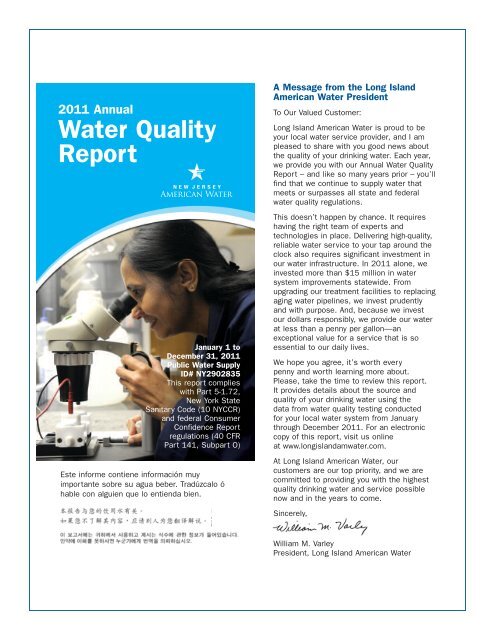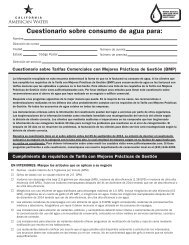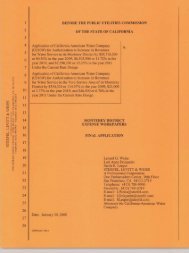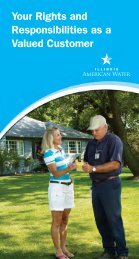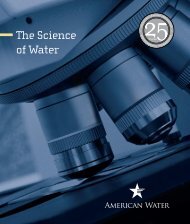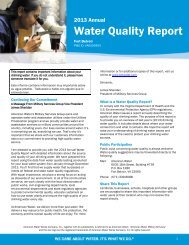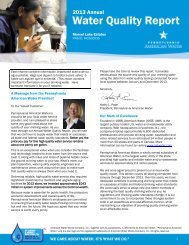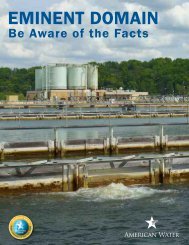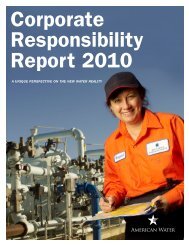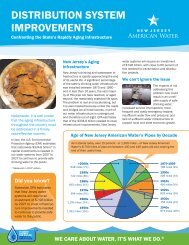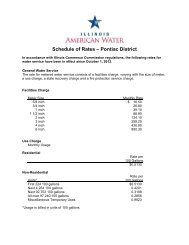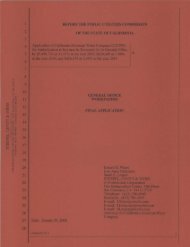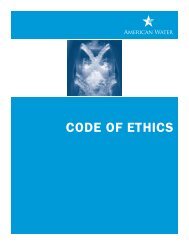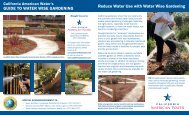Water Quality Report - American Water
Water Quality Report - American Water
Water Quality Report - American Water
Create successful ePaper yourself
Turn your PDF publications into a flip-book with our unique Google optimized e-Paper software.
2011 Annual<strong>Water</strong> <strong>Quality</strong><strong>Report</strong>January 1 toDecember 31, 2011Public <strong>Water</strong> SupplyID# NY2902835This report complieswith Part 5-1.72,New York StateSanitary Code (10 NYCCR)and federal ConsumerConfidence <strong>Report</strong>regulations (40 CFRPart 141, Subpart O)Este informe contiene información muyimportante sobre su agua beber. Tradúzcalo óhable con alguien que lo entienda bien.A Message from the Long Island<strong>American</strong> <strong>Water</strong> PresidentTo Our Valued Customer:Long Island <strong>American</strong> <strong>Water</strong> is proud to beyour local water service provider, and I ampleased to share with you good news aboutthe quality of your drinking water. Each year,we provide you with our Annual <strong>Water</strong> <strong>Quality</strong><strong>Report</strong> – and like so many years prior – you’llfind that we continue to supply water thatmeets or surpasses all state and federalwater quality regulations.This doesn’t happen by chance. It requireshaving the right team of experts andtechnologies in place. Delivering high-quality,reliable water service to your tap around theclock also requires significant investment inour water infrastructure. In 2011 alone, weinvested more than $15 million in watersystem improvements statewide. Fromupgrading our treatment facilities to replacingaging water pipelines, we invest prudentlyand with purpose. And, because we investour dollars responsibly, we provide our waterat less than a penny per gallon—anexceptional value for a service that is soessential to our daily lives.We hope you agree, it’s worth everypenny and worth learning more about.Please, take the time to review this report.It provides details about the source andquality of your drinking water using thedata from water quality testing conductedfor your local water system from Januarythrough December 2011. For an electroniccopy of this report, visit us onlineat www.longislandamwater.com.At Long Island <strong>American</strong> <strong>Water</strong>, ourcustomers are our top priority, and we arecommitted to providing you with the highestquality drinking water and service possiblenow and in the years to come.Sincerely,William M. VarleyPresident, Long Island <strong>American</strong> <strong>Water</strong>
How to Contact UsThank you… for allowing us to continue to provideyour family with quality drinking water this year.We ask that all our customers protect our watersources, which are the heart of our community.Please call our 24/7/365 Customer Call Centertoll-free if you have questions:Long Island <strong>American</strong> <strong>Water</strong>Customer Call Center: 1-877-426-6999 (24 hours)Emergencies: 1-877-426-6909 (24 hours)Automated Meter Reading Line: 1-800-672-1095TDD (Hearing/Speech impaired): 1-800-300-6202Lynbrook Administrative Office: 516-596-4800On-line: www.longislandamwater.com<strong>Water</strong> Information SourcesNew York State Department of Health1-518-473-8600 • www.health.state.ny.usNassau County Health Department516-227-9692 • www.co.nassau.ny.us/healthNew York State Department of Public Service1-800-342-3377 • www.dps.state.ny.usUS Environmental Protection Agencywww.epa.gov/safewaterEPA Safe Drinking <strong>Water</strong> Hotline1-800-426-4791<strong>American</strong> <strong>Water</strong> Works Associationwww.awwa.org<strong>Water</strong> <strong>Quality</strong> Associationwww.wqa.orgAbout Long Island <strong>American</strong> <strong>Water</strong>Long Island <strong>American</strong> <strong>Water</strong>, a wholly ownedsubsidiary of <strong>American</strong> <strong>Water</strong> (NYSE: AWK), is thelargest water supplier in Nassau County, providinghigh-quality and reliable water services toapproximately 220,000 people.About <strong>American</strong> <strong>Water</strong>Founded in 1886, <strong>American</strong> <strong>Water</strong> is the largestinvestor-owned U.S. water and wastewater utilitycompany. With headquarters in Voorhees, N.J., thecompany employs approximately 7,000 dedicatedprofessionals who provide drinking water, wastewaterand other related services to approximately 15million people in more than 30 states, as well asparts of Canada. More information can be found byvisiting www.amwater.com.Communities ServedAtlantic BeachBaldwinBaldwin HarborBarnum IslandBay ParkCedarhurstEast Atlantic BeachEast RockawayHarbor IsleHewlettHewlett Bay ParkHewlett HarborHewlett NeckInwoodIsland ParkLakeviewLawrenceLynbrookMalverneMalverne Park-OaksMeadowmereNorth LawrenceNorth LynbrookNorth WoodmereOceansideRooseveltSouth HempsteadValley StreamWest Hempstead*WoodmereWoodsburgh*community partiallyservedAverage Residential Usage & CostIn 2011, the average household usedapproximately 102,140 gallons of water at a costof $519, or $1.42 a day. With an average of 3.0persons per household, the cost of water wasabout 47¢ a day per person.Source, <strong>Quality</strong> & QuantityGroundwater is the source of your drinking watersupply. It is drawn from 162 wells located in theaquifer system beneath the land surface.The AquifersThe aquifers are water-bearing geologic deposits ofsand and clay that absorb and store about 45percent of the rain and snow that fall on LongIsland. Long Island <strong>American</strong> <strong>Water</strong> has wells in theUpper Glacial, Magothy, Jameco and Lloyd aquifers.Not all wells are operating at the same time, whichmeans that the water you receive is a blend oftreated water from different well locations (anintegrated system).If you have a private well which is unregulated and untested,you should not use the water for drinking or cooking.(Source: Nassau County Health Department)
Source <strong>Water</strong> AssessmentThe New York State Department of Health hasissued Source <strong>Water</strong> Assessments for each wellon Long Island to evaluate the susceptibility topossible contamination by microbials, nitrates,pesticides and volatile organic contaminants(VOC’s) based on current land uses and waterpumping patterns.The report concluded that the majority of wellshad high susceptibility for nitrates and VOCs, butwere not highly susceptible to contamination bymicrobials or pesticides.It is important to note that high susceptibility doesnot mean that the well will become contaminated.However, it does indicate that the contaminant islikely to be present above ground within the areaof the well, and if released into the ground couldtravel down through the aquifer and reach the well.Long Island <strong>American</strong> <strong>Water</strong> conducts acomprehensive testing program for the presenceof hundreds of contaminants. If they are presentat levels above drinking water standards, thewater is either treated to remove the contaminantor the well is removed from service. We workclosely with the Nassau County Health Departmentto assure that water delivered to our customersmeets all drinking water standards, as the testresults in this pamphlet show.For more information about this report, pleasecontact Long Island <strong>American</strong> <strong>Water</strong>’s <strong>Water</strong><strong>Quality</strong> Manager at 516-596-4824.How is Your <strong>Water</strong> Treated?Our water supply is obtained from wells locatedthroughout our service area. The wells range indepth from about 30 feet to 1,100 feet, averaging500 feet. In our area of southwestern NassauCounty, the soil has a naturally high iron andmineral content. The water dissolves thesenaturally occurring minerals, and while theyare not health hazards, they can causediscolored water.Bacteriological pollutants are not usually presentin wells at the average depth of 500 feet and,consequently, water directly from the well isdrinkable. However, water treatment is required toprotect the water in the distribution system and tominimize discolored water conditions.Treatment consists of:1. Chlorination for bacteriological disinfection2. Lime to raise pH and minimize corrosivity towater mains and household plumbing3. Filtration to remove iron at six well locations4. Sodium silicate to stabilize (sequester)iron not removed by filtration5. Air strippers to remove volatile organics atone locationSystem ImprovementsIn 2011, we continued to make significant upgradesto our system and infrastructure.These improvements include:• Completed 39 <strong>Water</strong> Main Replacement Projects,with 28,400 feet of new pipe installed (more than5 miles), with some highlighted as follows:• Completed replacement of 2,900 feet of watermain in East Rockaway• Completed replacement of 4,000 feet of watermain in Malverne• Completed replacement of 2,000 feet of watermain in Oceanside• Completed replacement of 3,600 feet of watermain along Doughty Blvd in Inwood and Lawrence• Replaced the Reynolds Channel 16” underwatertransmission main from Lawrence toAtlantic Beach• Replaced 70 fire hydrants• Replaced 402 service lines• Installed 35 new service lines• Completed electrical equipment replacements andupgrades at various pump station locationsthroughout our service territory• Completed rehabilitation of Well #17-1 onTanglewood Rd in LakeviewImprovements planned for 2012 include:• Re-drill 14 wells at Pump Station #5in Hewlett• Replace 50 fire hydrants• Replace 375 service lines• Replace 25,000 feet of water main in variouslocations throughout the service territory• Begin construction of an Iron Removal FilterPlant at Pump Station #15 on Whitehall St.in Lynbrook• Complete design and construction plans for a newWell #20-2 on Terrace Place in Valley Stream• Replacement of Well #9-2A on Hendrickson Ave inValley Stream• Rehabilitation of the ground storage tanks atStation #13 in Baldwin• Complete Well 2-1A rehabilitation on ChautauquaAve in Lakeview
Do I Need to Take Special Precautions?To ensure that tap water is safe to drink, the U.S.EPA prescribes regulations limiting the amount ofcertain contaminants in water provided by publicwater systems. U.S. Food and Drug Administrationregulations establish limits for contaminants inbottled water, which must provide the sameprotection for public health.Drinking water, including bottled water, mayreasonably be expected to contain at least smallamounts of some contaminants. The presence ofcontaminants does not necessarily indicate thatwater poses a health risk. More information aboutcontaminants and potential health effects can beobtained by calling the Environmental ProtectionAgency’s Safe Drinking <strong>Water</strong> Hotlineat 1-800-426-4791.Although our drinking water meets all state andfederal regulations, some people may be morevulnerable to disease-causing microorganisms orpathogens in drinking water than the generalpopulation. Immuno-compromised persons such aspersons with cancer undergoing chemotherapy,persons who have undergone organ transplants,people with HIV/AIDS or other immune systemdisorders, some elderly, and infants can beparticularly at risk from infections. These peopleshould seek advice from their health care providerabout their drinking water.If you have questions, contact theNassau County Department of Health at 516-227-9692. EPA/CDC guidelines on appropriate means tolessen the risk of infection by Cryptosporidium,Giardia and other microbial pathogens are availablefrom the Safe Drinking <strong>Water</strong> Hotlineat 1-800-426-4791.Substances Expected to be inDrinking <strong>Water</strong>In general terms, the sources of drinking water (both tap andbottled water) include rivers, lakes, streams, ponds,reservoirs, springs and wells. As water travels over thesurface of the land or through the ground, it dissolvesnaturally occurring minerals and can pick up substancesresulting from the presence of animals or fromhuman activities.Substances that may be present in sourcewater include:• Microbiological Contaminants: Such as viruses andbacteria, which may come from sewage treatmentplants, septic systems, agricultural livestock operationsor wildlife.• Inorganic Contaminants (IOC’s): Such as salts andmetals which can be naturally occurring or may resultfrom urban storm water runoff, industrial or domesticwastewater discharges, oil and gas production, miningor farming.• Pesticides and Herbicides (SOC’s): Which may comefrom a variety of sources such as agriculture, urban stormwater runoff and residential uses.• Organic Chemical Contaminants (VOC’s): Includingsynthetic and volatile organic chemicals which are byproductsof industrial processes and petroleumproduction, and may also come from gas stations, urbanstorm water runoff and septic systems.• Radioactive Contaminants: Which can be naturallyoccurring or may be the result of oil and gas productionand mining activities.For more information about contaminants and potentialhealth effects, call the EPA’s Safe Drinking <strong>Water</strong> Hotlineat 1-800-426-4791.Cryptosporidiosis & GiardiasisAlthough there have been no cases of Cryptosporidiosis inNassau County attributable to the water supply, we thoughtyou should be aware of the risks to people with severelyweakened immune systems. Cryptosporidiosis andGiardiasis are intestinal illnesses caused by microscopicparasites that can be transmitted a number of waysincluding through drinking water. Cryptosporidiosis can bevery serious for people with weak immune systems, such astransplant patients; individuals receiving chemotherapy ordialysis, and people with Crohn’s disease or HIV infection.Individuals who think they may have been exposed toCryptosporidiosis or Giardiasis should contact their healthcare providers immediately.Immuno-compromised patients who may have been advisedby their health care provider that they maybe at risk,especially when traveling, should observe the following:• One minute of boiling water at a rolling boil will killCryptosporidium parvum and Giardia lamblia.• Drinking bottled water does not guarantee that the wateris free from Cryptosporidiosis or Giardiasis.Contact your health care provider about your options. If youhave questions, contact the Nassau County Department ofHealth at 516-227-9692.
<strong>Water</strong> <strong>Quality</strong> FactsTo assure high quality water, individual water samples are taken each year for chemical, physical and microbiological tests. Testing canpinpoint a potential problem so that preventive action may be taken.Tests are done on water taken from the well (“raw water”), water within our treatment facilities, water exiting our treatment plants at thepoint-of-entry to the distribution system, and from sites located throughout our distribution system after treatment. These tests areconducted in the company’s state certified laboratory, by the Nassau County Health Department Laboratory, and by independent,certified laboratories approved by the state, who report results simultaneously to the company and to the Health Department.New York State allows us to monitor for certain contaminants less than once per year because the concentrations of thesecontaminants are not expected to vary significantly from year-to-year. Some of the data, though representative of the water quality, aremore than one year old.For a copy of the <strong>Water</strong> Supplement containing detailed data on testing at the source water wells before treatment, call usat 516-596-4824 and request a copy.<strong>Water</strong> <strong>Quality</strong> Table – Table of Detected Contaminants 2011REGULATED SUBSTANCESContaminant (units)DateSampledMicrobiologicalTotal Coliform (% positive samples inany given month)12/111MCLMCL = >5%samples positiveMCLGMaximumAmount DetectedRange:Low-HighComplianceAchievedTypical Source0 0.00% ND = 0.0% Yes Naturally present in the environmentRadiological 2Gross Alpha Activity (pCi/L) 11/10 15 0 5.22 ND – 5.22 Yes Erosion of natural depositsRadium-228 (pCi/L) 11/10 5 0 4.56 ND – 4.56 Yes Erosion of natural depositsGross Beta Activity (pCi/L) 3 11/10 50 0 4.04 0.47 – 4.04 YesDecay of natural deposits andman-made emissionsDisinfection By-productsTTHM’s [Total Trihalomethanes] (ppb) 4 12/11 80 0 13.9 0.5 – 13.9 Yes By-product of drinking water disinfectionDibromoacetic Acid (ppb) 12/11 60 0 2.2 ND – 2.2 Yes By-product of drinking water disinfectionDisinfectantsChlorine (ppm) 12/11 MRDL = 4.0 MRDLG = 4.0 1.45 ND – 1.45 Yes <strong>Water</strong> additive used to control microbesLead and Copper Rule (Tap water samples were collected from 50 homes in the service area)Contaminant (units)DateSampledActionLevelMCLGAmount Detected(90th %tile)Range: Low-HighHomes AboveAction LevelViolation Typical SourceCopper (ppm) 9/11 1.3 1.3 0.146 5 ND – 0.239 0 No Corrosion of household plumbing systemsLead (ppb) 9/11 15 0 6.0 6 ND – 37.0 1 No Corrosion of household plumbing systemsMetals & Inorganic SubstancesContaminant (units)DateSampledMCL MCLGMax. Amount Range:DetectedLow-HighTypical SourceBarium (ppb) 12/11 2000 2000 7 ND – 7.0 Naturally occurringChlorides (ppm) 12/11 250 N/A 22.9 8.0 – 22.9 Naturally occurring or indicative of road salt contaminationIron (ppb) 7 12/11 300 N/A 630 140 – 630 Naturally occurringManganese (ppb) 8 12/11 300 N/A 37 ND – 37 Naturally occurringNitrates as N (ppm) 12/11 10 10 0.07 ND – 0.07 Erosion of natural deposits; Runoff from fertilizers and septic tanksNickel (ppb) 12/11 100 N/A 3.8 ND – 3.8 Naturally occurringSodium (ppm) 9 12/11 None N/A 15.2 9.8 – 15.2 Naturally occurring; Road salt; <strong>Water</strong> softenersSulfate (ppm) 12/11 250 N/A 45 7.6 – 45.0 Naturally occurringOrganic SubstancesContaminant (units) Date Sampled MCL MCLG Maximum Amount Detected Range: Low-High Typical SourceDacthal (ppb) 10 12/11 50 N/A 3 ND – 3 Agricultural herbicide
Listing of Non-Detected (ND) Contaminants (2011)None of the following compounds that we analyzed for were detected in your drinking water at the respectivemethod detection levels:Microbiological:Total ColiformsE. coliInorganics & Physical:Ammonia as NCyanide, freeFluorideNitrite as NPerchlorateSurfactants (as MBAS)TurbidityMetals:AntimonyArsenicBoronBerylliumCadmiumChromiumCobaltMercuryMolybdenumPotassiumSeleniumSilverThalliumVanadiumZincMiscellaneous:Asbestos fibersDisinfection By-Products -Haloacetic Acids:Monochloroacetic AcidTrichloroacetic AcidMonobromoacetic AcidDichloroacetic AcidBromochloroacetic AcidVolatile OrganicCompounds (VOC’s):BenzeneBromobenzeneBromochloromethaneBromomethanen-Butylbenzenesec-Butylbenzenetert-ButylbenzeneCarbon TetrachlorideChlorobenzeneChloroethaneChloromethane2-Chlorotoluene4-ChlorotolueneDibromomethane1,2-Dichlorobenzene1,3-Dichlorobenzene1,4-Dichlorobenzene (Meta)Dichlorodifluoromethane1,1-Dichloroethane1,2-Dichloroethane1,1-Dichloroethanecis-1,2-Dichloroethenetrans-1,2-Dichloroethene1,2-Dichloropropane1,3-Dichloropropane2,2-Dichloropropane1,1-Dichloropropenecis-1,3-Dichloropropenetrans-1,3-DichloropropeneEthylbenzeneHexachlorobutadineneIsopropylbenzene4-IsopropyltolueneMethylene Chloride(Dichloromethane)Methyl Tert. Butyl Ether (MTBE)n-PropylbenzeneStyrene1,1,1,2-Tetrachloroethane1,1,2,2-TetrachloroethaneTetrachloroethene (PCE)Toluene1,2,3-Trichlorobenzene1,2,4-Trichlorobenzene1,1,1-Trichloroethane1,1,2-TrichloroethaneTrichloroethene (TCE)Trichlorofluoromethane1,2,3-Trichloropropane1,2,4-Trimethylbenzene1,3,5-TrimethylbenzeneM-XyleneO-XyleneP-XyleneVinyl ChlorideSynthetic OrganicCompounds (SOC’s):*Regulated Group #1:AlachlorAldicarbAldicarb SulfoneAldicarb SulfoxideAtrazineCarbofuranChlordane, Total1,2-Dibromo-3-Chloropropane(DBCP)2,4-DEndrin1,2-Dibromomethane (EDB)HeptachlorHeptachlor EpoxideLindaneMethoxychlorPCB’sPentachlorophenolToxaphene2,4,5-TP (Silvex)Regulated Group #2:AldrinBenzo(a)pyreneButachlorCarbarylDalaponDi (2-Ethylhexyl) adipateDi (2-Ethylhexyl) phthalalteDicambaDieldrinDinosebDiquatEndothallGlyphosateHexachlorobenzeneHexachlorocyclopentadiene3-HydroxycarbofuranMethomylMetolachlorMetribuzinOxamyl (Vydate)PicloramPropachlorSimazine2,3,7,8-TCDD (Dioxin)Unregulated SOC’s:*2,4-DB2,4,5-T3,5-Dichlorobenzoic AcidAcifluorfenBentazonDichlorpropMethiocarb*Synthetic Organic Compounds(SOC’s) are mainly Pesticidesand Herbicides, and arerequired on raw water wells, asper NCDOH requirements.Unregulated ContaminantMonitoring Rule (UCMR2):The following parameters weretested for as per a requiredUSEPA monitoring program totry to quantify the presenceand amount of emerging orunregulated compounds to seeif any should be regulated bythe EPA.The following contaminants thatwe tested for on the treatedwater exiting our treatmentplants were “Non-detected”:(Note: All UCMR2 parameterstested for were not detected):2,2’,4,4’,5,5’-Hexabromobiphenyl2,2’,4,4’,6-Pentabromodiphenyl Ether2,2’,4,4’,5,5’-Hexabromodiphenyl Ether2,2’,4,4’,- TetrabromodiphenylEther2,2’,4,4’,5-Pentabromodiphenyl EtherDimethoateTerbufos Sulfone1,3-DinitrobenzeneHexahydro-1,3,5-Trinitro-1,3,5-Triazine2,4,6-TrinitrotolueneAcetochlorAlachlorMetolachlorAcetochlor ESAAcetochlor OAAlachlor ESAAlachlor OAMetolachlor ESAMetolachlor OAN-Nitroso-Di-N-Butylamine(NDBA)N-Nitroso-Diethylamine(NDEA)N-Nitroso-Dimethylamine(NDMA)N-Nitroso-Di-N-Propylamine(NDPA)N-Nitroso-Methylethylamine(NMEA)N-Nitroso-Pyrrolidine(NPYR)


